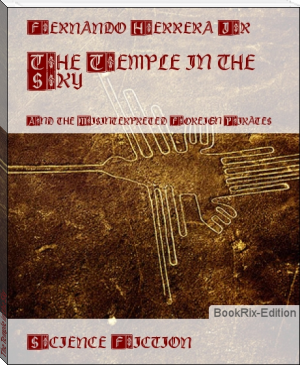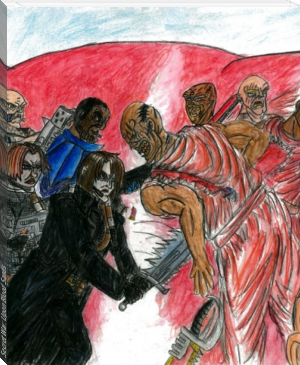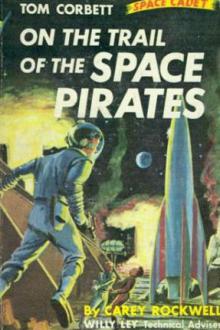The Temple in the Sky, Fernando Herrera Jr [the rosie project .txt] 📗

- Author: Fernando Herrera Jr
Book online «The Temple in the Sky, Fernando Herrera Jr [the rosie project .txt] 📗». Author Fernando Herrera Jr
his hand and pull him off. “That’s ours, over there,” she instructed pointing to an olive colored tram. “All these trams go to different divisions of the school. We’re lucky. We only have to ride this thing for ten minutes. The high-school students have to ride for at least thirty more minutes. And the poor college students--see that building all the way over there?” She signaled all the way to the horizon to a barely noticeable structure that peeked out of the fog. Apaec nodded. “That’s the University. This is the only track... and this is the closest it gets to school... so they have no choice but to ride all the way over there in a tram like this one. That’s why there isn’t any college alumni around right now--because they’re all already half way there. The first train picks them up an hour before us. It’s gonna suck when we get that age.” Apaec thought to himself that could be true but he wondered if he would still live there then. Maybe by then he would have found the temple in the sky and perhaps Chapwook would have found a way to get him home.
Ironically enough, Apaec’s first period was astronomy. He entered the class a few minutes late, right after an introductory lecture by the instructor who was an activist Pippolian and happened to be fanatically fond of nature. He wore very dull colored clothing and had a long, red beard. With a voice that resembled a goat’s moan, he began: “Welcome children to a new semester. As you know, this is astronomy B, and in astronomy B we will be talking about our galaxy--The Ruby Cotton Galaxy. This here I have in my hand is a very magnificent term paper turned in to me by an accomplished student I had a few years ago. He is now abroad working on his thesis on the modern string theory. I will read it to you because It’s very appropriate to this class’s theme. It goes something like this--” He pulled a paper out of an envelope as he cleared his throat and continued, “A sorcerer—the sorcerer sits atop his cloud, spoon in hand, stirring his brew amidst for sure: a brew of bugs, a brew of mammals, a brew of us and them; the young, the old, the smart the dumb; love and hate, peace and fury; chemicals of materials and materials of chemicals; elements of beta, elements of gamma, the purest of Ylem, of course; rocks and boulders, fruits and poisons, slime and grime, fungus and flowers and chemical showers of toxic rains. Here lays that universal question that many have forged, for decades perhaps—and as of today, may be socially accepted as a sapient thought; because according to science and astronomy there burns about 100,000,000,000 stars in the Ruby Cotton Galaxy alone. The oppugn? Here: Life on a planet besides our own—not necessarily intelligent—just alive. How may we figure? Here: By logical elimination, let us take 25 percent of them, which then leaves 25,000,000,000, including red giants and white dwarfs, dying or warming. We can get an approximate number of stars with a Polis-like planet and the number of planets with possible life: 370 known worlds orbiting their masters other than our own. “Exoplanets:” Only one more of than the digits of your hands put together have been photographed: worlds so strange, so queer, that we cannot suppose how they appear. An example? There is a planet that whirls 260 light years away, with a year that lasts from Monday morning to Wednesday night. Another: a 150 light years out, has a tail like a comet because its colorful atmosphere is being blasted away. The remains of once omnipotent stars, shrunk to a spinning atomic nucleus merely the size of Pippolas can be found wandering amidst the eternal darkness of the space continuum. Planets much like our own, benighted, as Polis will someday become, flung out of their orbits and expired forever. Out of the 25,000,000,000, assuming 10 percent are as young as our sun, preferably white dwarfs, the number then decreases to 2,500,000,000. They would be burning livid, and more or less, about the size of our sun. The age would suffice to create planets with the debris that flow about the colorful nebulas. Of those 2,500,000,000, 10 percent may actually form planets. There are thirteen planets in our solar system, going by the shift in the respective star. Most of the interstellar planets found by researchers have been determined to be humongous and much larger than Polis. Roughly 250,000,000 stars have planets the size of earth and roughly ten percent of those stars may have rocky type planets. This brings us to 25,000,000 stars. Let us assume these planets orbit about the habitable zone, where conditions are cool enough to sustain life. Polis is 96,000,000 miles from Sun A, close enough for us not to freeze, or maybe far enough for us not to burn, but definitely close enough to render just the right amount of sunlight, heat, and radiation for us to breath. Out of those 25,000,000, ten percent might have planets in the habitable zone: so 2,500,000 planets with a narrow chance. These planets may have that clairvoyant potion of the Sorcerer’s brew. And just to be a little more prudent, let us eliminate some more and end with 250,000: The grand finale? Not. Because the space and time continuum is flighty by nature, therefore, as of today, some might just be expired, and others might be in their early awakenings. We end at 25,000 by process of logical elimination. The grand finale: So, 25,000 stars with planets orbiting them, and one of them, out of all that jazz, happens to sustain intelligent life: Gleese 581 to be exact: a red dwarf star with a spectral type M3V that is the 87th closest known star system to our sun, a star that travels through many constellations: a third the mass of our sun, and about 20.3 light years away, there gravitates Earth: A far planet that tugs on Gleese 581, within its life supporting, habitable zone: about seven times the mass of Polis: a planet. It is called Gleese 581d by astronomers: 95% water, 5% terra firma. But that 5% is equivalent to almost the entire terra firma of polis. By scarce probabilities, it became alive: five moons at satellite, orbiting its host in 66.8 days, a year far shorter than our own. Earth timeframe: unknown...
“Any questions?” A young boy raised his hand. “You, son. What is your question? Hmm?”
“Is the sorcerer god?” The instructor was distraught for a moment. “Because my mom said that teacher’s aren’t allowed to talk to us about god in class,” the boy added.
“Uh... well, no. This was a research paper turned in by one of my students a few years back. The sorcerer, as he calls this creator thing, is just what he refers to whatever created--” He stopped and continued, “--Students... this is not the point, you see? You’re missing the whole point of this paper. The point is that it is very possible that there exists life out there... somewhere far beyond our galaxy... or maybe not too far.”
The same boy interrupted the professor, “You mean like that brown boy who appeared outta nowhere last year?”
The teacher squinted as he scratched his beard. He cleared his throat once again. “Well, we don’t know where he came from. He may just be a product of nature’s adaptive---”
He was interrupted by Apaec who then entered the classroom. A loud commotion followed.
The school was a complete academic center that had been founded by a revolutionary named Lumen Ziggin. He was a renowned architect who was responsible for most of the modern urban planning of the capital of Aledren. Though he was an Aledren, on a trip to Pippolas, he fell in love with a young pippolian girl who was assigned to him as a servant. He married her on the same trip and had a daughter with her after a year. Because he had broken the law, he was left without a choice but to stay in Pippolas. He retrieved all of his fortunes from Aledren and took them to Pippolas. There, after only nine years, his wife and daughter were slain by a racist Aledren gang inside their home. Needless to say, Lumen was completely ravaged for life. A paladin at heart, he decided to commit the rest of his life to take his revenge as a vigilante. Thence, he singlehandedly avenged the murder of his family. He slaughtered the entire gang within six months, one by one, killing them off like flies. For this, he was labeled as an outlaw and a price was set on his head. For the remainder of his life, he lived as a fugitive as he fought intensely for the rights of the Pippolians. He was eventually assassinated at the age of thirty-five by a Pippolian traitor who was bought by the Aledren regime. But in his will, he left a plan pending--a plan for an international academic center--a school that had all grades--every single grade from preschool to doctorates. He left billions of currency to his followers who used the money to build the most outstanding academy that Polis had ever seen. Before that, Pippolas had not a way to finance such institutions, therefore children were home-schooled by their limited parents. The Ziggin followers built it upon Lumen’s 30,500 acre property which was also left in the will. The school, which resembled more a magnificent castle, had been designed by lumen himself--an architect of great prestige--and for that reason, it was a beautiful landmark and just like the legendary Hanging Gardens of Babylon, was considered a wonder and treasure of Polis. Imagine three medieval castles set in the middle of an untamed forest, built side by side and juxtaposed to three more, all of which were connected by tremendous walls, massive balustrades, and enormous towers--towers that were impossibly tall--ponds and lakes surrounding them in mottles and trees as tall as buildings sheltering most of the school property--and within the main structures, lush, beautiful gardens and courtyards fit for the monarchies. Because the school had been built by Pippolian workers and with rightful Pippolian currency, Aledren was not able to interfere in the marvelous project. The funds were more than sufficient for the colossal project and the resources were more than abundant. In less than four years, the school was completed. Once the school was up and running, it was maintained by the Pippolian people and likewise funded by the people for the people, and the fees would be equal to all people, regardless of citizenship. For that reason, this particular center was the school for all kinds of races and classes of people. For Lumen’s request, the school’s staff could be of any race and any citizenship. People all around the world migrated to Pippolas in order to attend L.Z.P.S.Z. Donations were continuously made by patrons around the world. It was a wondrous mecca to behold.
The day after, Apaec arrived home with Adonia. Harggot approached from a path.
“Apaec!” he cried.
“Yes, Harggot?” Adonia left the scene.
“Whatcha gonna do right this moment?”
“Nothing, really.”
“Well, howbout you come over to ma tree an let me teach ya the sport at which I am a master.”
“What’s that, Harggot?”
“The martial art of Tunkah. Soon you will have to taka da physical education and the boys will make fun of ya if you don’t know any Tunkah,” he said while putting his arm around Apaec.
“What is that?”
“It is the martial art of our ancestors, it is. Magic art.” They walked the path to Harggot’s residence.
“Magic, you say? You mean, like sorcery?”
“Not quite, my friend. Has Chapwook told ya bout my trophies?”
“What trophies, Harg?”
He grinned
Ironically enough, Apaec’s first period was astronomy. He entered the class a few minutes late, right after an introductory lecture by the instructor who was an activist Pippolian and happened to be fanatically fond of nature. He wore very dull colored clothing and had a long, red beard. With a voice that resembled a goat’s moan, he began: “Welcome children to a new semester. As you know, this is astronomy B, and in astronomy B we will be talking about our galaxy--The Ruby Cotton Galaxy. This here I have in my hand is a very magnificent term paper turned in to me by an accomplished student I had a few years ago. He is now abroad working on his thesis on the modern string theory. I will read it to you because It’s very appropriate to this class’s theme. It goes something like this--” He pulled a paper out of an envelope as he cleared his throat and continued, “A sorcerer—the sorcerer sits atop his cloud, spoon in hand, stirring his brew amidst for sure: a brew of bugs, a brew of mammals, a brew of us and them; the young, the old, the smart the dumb; love and hate, peace and fury; chemicals of materials and materials of chemicals; elements of beta, elements of gamma, the purest of Ylem, of course; rocks and boulders, fruits and poisons, slime and grime, fungus and flowers and chemical showers of toxic rains. Here lays that universal question that many have forged, for decades perhaps—and as of today, may be socially accepted as a sapient thought; because according to science and astronomy there burns about 100,000,000,000 stars in the Ruby Cotton Galaxy alone. The oppugn? Here: Life on a planet besides our own—not necessarily intelligent—just alive. How may we figure? Here: By logical elimination, let us take 25 percent of them, which then leaves 25,000,000,000, including red giants and white dwarfs, dying or warming. We can get an approximate number of stars with a Polis-like planet and the number of planets with possible life: 370 known worlds orbiting their masters other than our own. “Exoplanets:” Only one more of than the digits of your hands put together have been photographed: worlds so strange, so queer, that we cannot suppose how they appear. An example? There is a planet that whirls 260 light years away, with a year that lasts from Monday morning to Wednesday night. Another: a 150 light years out, has a tail like a comet because its colorful atmosphere is being blasted away. The remains of once omnipotent stars, shrunk to a spinning atomic nucleus merely the size of Pippolas can be found wandering amidst the eternal darkness of the space continuum. Planets much like our own, benighted, as Polis will someday become, flung out of their orbits and expired forever. Out of the 25,000,000,000, assuming 10 percent are as young as our sun, preferably white dwarfs, the number then decreases to 2,500,000,000. They would be burning livid, and more or less, about the size of our sun. The age would suffice to create planets with the debris that flow about the colorful nebulas. Of those 2,500,000,000, 10 percent may actually form planets. There are thirteen planets in our solar system, going by the shift in the respective star. Most of the interstellar planets found by researchers have been determined to be humongous and much larger than Polis. Roughly 250,000,000 stars have planets the size of earth and roughly ten percent of those stars may have rocky type planets. This brings us to 25,000,000 stars. Let us assume these planets orbit about the habitable zone, where conditions are cool enough to sustain life. Polis is 96,000,000 miles from Sun A, close enough for us not to freeze, or maybe far enough for us not to burn, but definitely close enough to render just the right amount of sunlight, heat, and radiation for us to breath. Out of those 25,000,000, ten percent might have planets in the habitable zone: so 2,500,000 planets with a narrow chance. These planets may have that clairvoyant potion of the Sorcerer’s brew. And just to be a little more prudent, let us eliminate some more and end with 250,000: The grand finale? Not. Because the space and time continuum is flighty by nature, therefore, as of today, some might just be expired, and others might be in their early awakenings. We end at 25,000 by process of logical elimination. The grand finale: So, 25,000 stars with planets orbiting them, and one of them, out of all that jazz, happens to sustain intelligent life: Gleese 581 to be exact: a red dwarf star with a spectral type M3V that is the 87th closest known star system to our sun, a star that travels through many constellations: a third the mass of our sun, and about 20.3 light years away, there gravitates Earth: A far planet that tugs on Gleese 581, within its life supporting, habitable zone: about seven times the mass of Polis: a planet. It is called Gleese 581d by astronomers: 95% water, 5% terra firma. But that 5% is equivalent to almost the entire terra firma of polis. By scarce probabilities, it became alive: five moons at satellite, orbiting its host in 66.8 days, a year far shorter than our own. Earth timeframe: unknown...
“Any questions?” A young boy raised his hand. “You, son. What is your question? Hmm?”
“Is the sorcerer god?” The instructor was distraught for a moment. “Because my mom said that teacher’s aren’t allowed to talk to us about god in class,” the boy added.
“Uh... well, no. This was a research paper turned in by one of my students a few years back. The sorcerer, as he calls this creator thing, is just what he refers to whatever created--” He stopped and continued, “--Students... this is not the point, you see? You’re missing the whole point of this paper. The point is that it is very possible that there exists life out there... somewhere far beyond our galaxy... or maybe not too far.”
The same boy interrupted the professor, “You mean like that brown boy who appeared outta nowhere last year?”
The teacher squinted as he scratched his beard. He cleared his throat once again. “Well, we don’t know where he came from. He may just be a product of nature’s adaptive---”
He was interrupted by Apaec who then entered the classroom. A loud commotion followed.
The school was a complete academic center that had been founded by a revolutionary named Lumen Ziggin. He was a renowned architect who was responsible for most of the modern urban planning of the capital of Aledren. Though he was an Aledren, on a trip to Pippolas, he fell in love with a young pippolian girl who was assigned to him as a servant. He married her on the same trip and had a daughter with her after a year. Because he had broken the law, he was left without a choice but to stay in Pippolas. He retrieved all of his fortunes from Aledren and took them to Pippolas. There, after only nine years, his wife and daughter were slain by a racist Aledren gang inside their home. Needless to say, Lumen was completely ravaged for life. A paladin at heart, he decided to commit the rest of his life to take his revenge as a vigilante. Thence, he singlehandedly avenged the murder of his family. He slaughtered the entire gang within six months, one by one, killing them off like flies. For this, he was labeled as an outlaw and a price was set on his head. For the remainder of his life, he lived as a fugitive as he fought intensely for the rights of the Pippolians. He was eventually assassinated at the age of thirty-five by a Pippolian traitor who was bought by the Aledren regime. But in his will, he left a plan pending--a plan for an international academic center--a school that had all grades--every single grade from preschool to doctorates. He left billions of currency to his followers who used the money to build the most outstanding academy that Polis had ever seen. Before that, Pippolas had not a way to finance such institutions, therefore children were home-schooled by their limited parents. The Ziggin followers built it upon Lumen’s 30,500 acre property which was also left in the will. The school, which resembled more a magnificent castle, had been designed by lumen himself--an architect of great prestige--and for that reason, it was a beautiful landmark and just like the legendary Hanging Gardens of Babylon, was considered a wonder and treasure of Polis. Imagine three medieval castles set in the middle of an untamed forest, built side by side and juxtaposed to three more, all of which were connected by tremendous walls, massive balustrades, and enormous towers--towers that were impossibly tall--ponds and lakes surrounding them in mottles and trees as tall as buildings sheltering most of the school property--and within the main structures, lush, beautiful gardens and courtyards fit for the monarchies. Because the school had been built by Pippolian workers and with rightful Pippolian currency, Aledren was not able to interfere in the marvelous project. The funds were more than sufficient for the colossal project and the resources were more than abundant. In less than four years, the school was completed. Once the school was up and running, it was maintained by the Pippolian people and likewise funded by the people for the people, and the fees would be equal to all people, regardless of citizenship. For that reason, this particular center was the school for all kinds of races and classes of people. For Lumen’s request, the school’s staff could be of any race and any citizenship. People all around the world migrated to Pippolas in order to attend L.Z.P.S.Z. Donations were continuously made by patrons around the world. It was a wondrous mecca to behold.
The day after, Apaec arrived home with Adonia. Harggot approached from a path.
“Apaec!” he cried.
“Yes, Harggot?” Adonia left the scene.
“Whatcha gonna do right this moment?”
“Nothing, really.”
“Well, howbout you come over to ma tree an let me teach ya the sport at which I am a master.”
“What’s that, Harggot?”
“The martial art of Tunkah. Soon you will have to taka da physical education and the boys will make fun of ya if you don’t know any Tunkah,” he said while putting his arm around Apaec.
“What is that?”
“It is the martial art of our ancestors, it is. Magic art.” They walked the path to Harggot’s residence.
“Magic, you say? You mean, like sorcery?”
“Not quite, my friend. Has Chapwook told ya bout my trophies?”
“What trophies, Harg?”
He grinned
Free e-book «The Temple in the Sky, Fernando Herrera Jr [the rosie project .txt] 📗» - read online now
Similar e-books:





Comments (0)